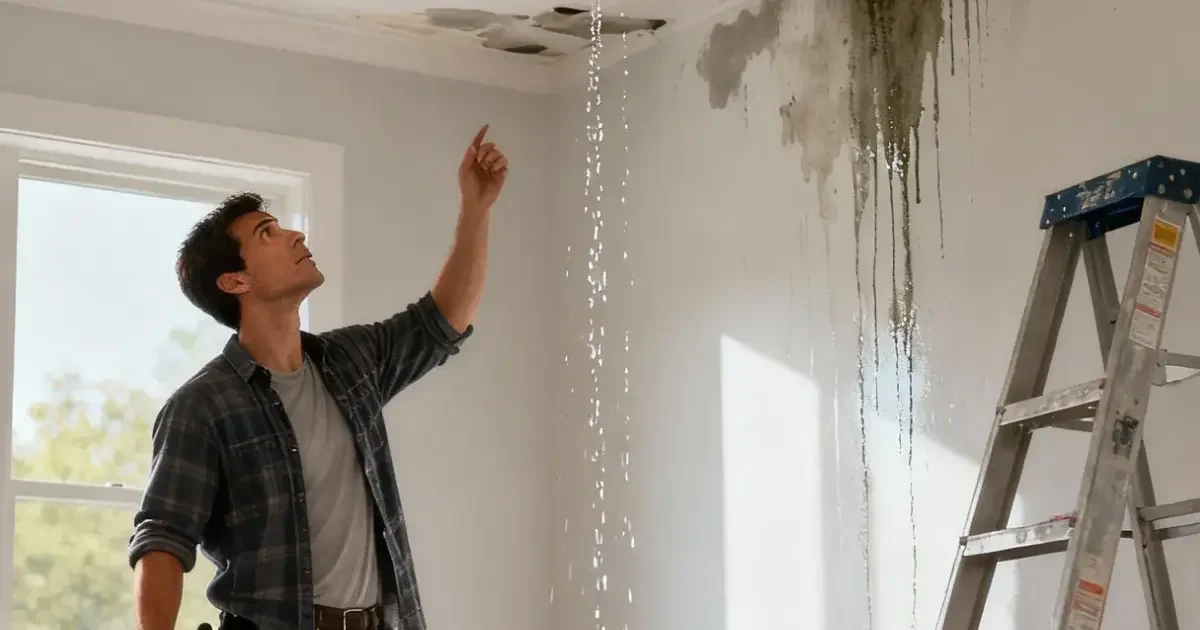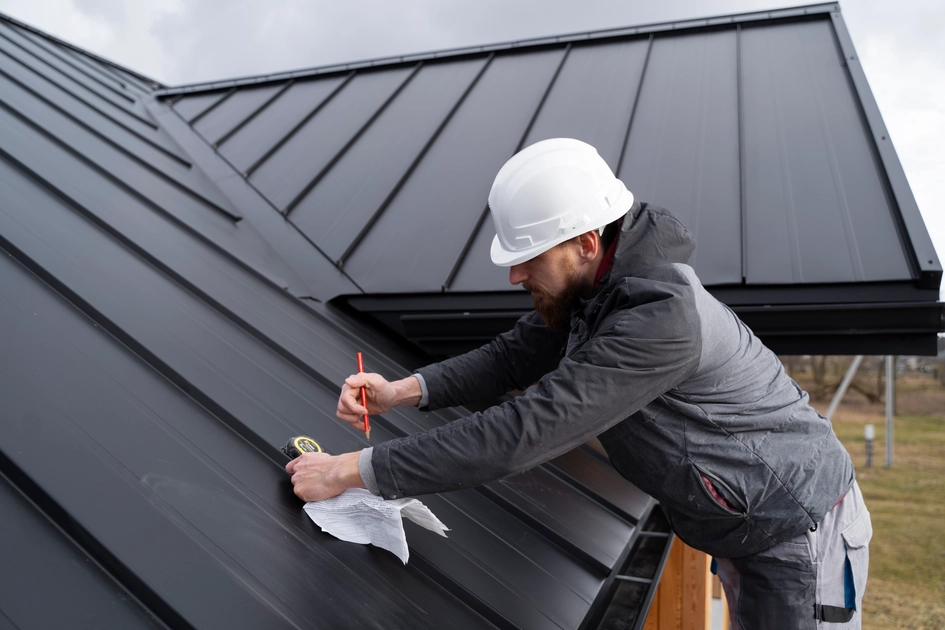With proper knowledge and tools, you can address roof leaks before they cause extensive damage to your home. A leaking roof isn’t just an inconvenience—it can lead to structural damage, mould growth, and expensive repairs if left untreated. Whether you’re considering a temporary patch or a permanent solution, understanding how to locate and repair leaks is vital for protecting your property. This comprehensive roof leaks fix and guide will help you identify the source of your leak, determine the best repair method, and decide whether to tackle the job yourself or call in professionals.
Table of Contents
What is a Roof Leak?
A roof leak occurs when water penetrates through your roofing system and enters your home’s interior structure. Even small leaks can cause significant damage if left unaddressed, leading to rotted timber, damaged insulation, electrical hazards, and mould growth. Water follows the path of least resistance, often traveling along structural elements before becoming visible inside your home. Your roof acts as your home’s primary defense against weather, and any breach in this barrier allows moisture to compromise the entire structure beneath it.
Common Causes of Roof Leaks
Common causes of a leaking roof include damaged or missing shingles, cracked flashing, clogged gutters, and poor installation, all of which can lead to significant water damage inside your home. Roof valleys are particularly vulnerable, as they concentrate water during rainfall, and broken tiles can allow water to seep beneath them. Additionally, tree branches may wear down protective layers, while hail can compromise shingles. Regular roof inspections and maintenance are essential to identify the source of leaks early, and homeowners should consider contacting a professional roof plumber for repairs or replacement to ensure the longevity of their roof and prevent further issues.
The Importance Of Regular Roof Inspections
You should inspect your roof at least twice annually—once before the wet season and again after severe weather events. Schedule these inspections during autumn and spring for optimal results. Bi-annual inspections can extend your roof’s lifespan by up to 40% according to industry studies. Focus on areas around chimneys, vents, and valleys where water naturally accumulates. After major storms or hail events, conduct additional spot checks to assess any immediate damage that could worsen with the next rainfall.
Professional Roof Inspection vs. DIY
To address a leaking roof, it’s crucial for homeowners to inspect their roof regularly, as common causes of roof leaks include flashing issues, damaged shingles, or debris in gutters that can lead to water damage inside your home. While DIY inspections can help identify visible problems, contacting a professional roof plumber is often necessary, especially for steep-pitched or older roofs, to ensure a thorough roof inspection and detect hidden leaks. Investing in a professional roof inspection can prevent significant structural issues and extend the longevity of your roof, ultimately saving you money on roof repair or even replacement costs.
Basic Tools Needed for Roof Repairs
Your toolkit should include a sturdy extension ladder rated for your weight plus materials, a hammer or nail gun for securing shingles, a utility knife with extra blades for cutting materials, a pry bar for removing damaged shingles, and a caulking gun for applying sealants. You’ll also need a wire brush for cleaning surfaces, measuring tape, chalk line for marking straight lines, and a broom for clearing debris. A cordless drill with various bits proves invaluable for metal roof repairs and securing patches.
Essential Materials for Fixing Roof Leaks
To address a leaking roof, it’s essential to stock up on roofing materials suitable for your roof type, including roofing cement or sealant, replacement shingles, flashing material, and patching fabric. For metal roofs, specialized sealants and screws with rubber washers are necessary, while tile roofs require mortar mix and replacement tiles. The quality of these materials affects the longevity of your roof repair, as premium sealants can last up to 20 years compared to budget options that may crack sooner. Selecting the right materials, like architectural-grade shingles for better wind resistance and corrosion-resistant flashing, is crucial for effective roof maintenance and preventing further water damage.
Preparing for Roof Repair
Before you climb onto your roof with tools in hand, proper preparation can mean the difference between a successful repair and a dangerous situation. You’ll need to gather the right equipment, assess weather conditions, and ensure you have safe access to the damaged area. Taking the time to prepare thoroughly will streamline your repair process and help you avoid costly mistakes that could lead to additional damage.
Assessing the Damage
Start by documenting the full extent of the leak from both inside and outside your home. Take photos of water stains, damaged shingles, and any structural concerns you observe. Measure the affected area to determine how much material you’ll need for repairs. Check surrounding sections for hidden damage—leaks often spread beyond the obvious wet spots. This assessment will help you decide whether you’re dealing with a simple patch job or a more extensive repair requiring professional intervention.
Securing the Area
If you’re wondering why your roof is leaking, it’s essential to inspect your roof for common causes such as damaged shingles, flashing issues, or clogged gutters that could lead to water damage inside your home. Regular roof maintenance and prompt identification of the source of the leak can prevent further structural issues and extend the life of your roof. Homeowners should consider professional roof inspection or roof repair services to fix a leaking roof effectively, ensuring their roof remains in good condition and protecting their home from potential damage.
Temporary Fixes for Leaking Roofs
Sometimes you need to act fast to prevent water damage while you arrange for permanent repairs. Temporary solutions can buy you several weeks or even months, depending on the severity of the leak and weather conditions in your area. These quick fixes work best for minor leaks and should always be followed up with proper professional repairs to ensure your roof’s long-term integrity.
Quick Patch Solutions
Roofing cement offers one of the fastest ways to stop an active leak. You can apply it directly to small cracks or holes using a putty knife, creating an immediate waterproof barrier. Roof patch kits available at hardware stores typically cost between AUD 20 to AUD 60 and include everything you need for emergency repairs. Silicone-based patches work particularly well on metal roofs, while bitumen-based products suit asphalt shingles better. Apply these patches on dry surfaces whenever possible for maximum adhesion.
Utilizing Tarps and Sealants
To address a leaking roof, using heavy-duty tarps can provide a temporary fix while you wait for professional roof repair. A tarp measuring 6×8 meters can cost between AUD 50 to AUD 150 and should be secured to undamaged areas of your roof to prevent water from seeping into your home. Proper positioning is key, extending the tarp at least one meter beyond the leak, and pairing it with waterproof sealants can help protect against further water damage. Regularly inspect your tarp during storms and reinforce it as needed to ensure it effectively prevents additional issues from a damaged roof.
Finding the Source of the Leak
Tracing water back to its entry point often proves more challenging than homeowners expect. Water can travel several metres along rafters, beams, or insulation before dripping onto your ceiling, making the visible stain inside your home a poor indicator of the actual roof penetration. You’ll need to examine your attic during daylight hours, looking for light penetrating through gaps or water trails along structural members. Mark suspicious areas with chalk, then verify them from the exterior during dry conditions. Professional roofers estimate that 70% of leaks originate within one metre of roof penetrations—chimneys, vents, skylights, or valleys where two roof planes meet.
Inspecting Roof Flashing
Flashing around chimneys, vent pipes, and skylights represents your roof’s most vulnerable points. Deteriorated sealant, rust spots, or gaps between the flashing and roofing material allow water to penetrate beneath shingles. Check for lifted edges where flashing meets vertical surfaces, as thermal expansion and contraction can break these seals over time. Metal flashing typically lasts 20-30 years, but the caulking requires reapplication every 5-7 years depending on your climate exposure.
Checking Gutter Systems
Common causes of a leaking roof often stem from issues with gutters, such as blockages that force water to pool and seep under shingles, leading to potential water damage inside your home. Homeowners should regularly inspect their roof and gutters to ensure proper drainage and identify the source of any leaks. Insufficient gutter capacity can overwhelm during heavy rainfall, causing water to penetrate the roof and damage roofing materials. Additionally, sagging gutters and inadequate slope can create low spots, allowing standing water to accumulate and cause further issues. To protect your home, maintaining your roof and addressing roof leaks early with professional roof repair is essential for ensuring the longevity of your roof.
Repairing Different Roof Types
Different roofing materials require specific repair techniques to ensure lasting protection against water infiltration. Asphalt shingles, metal panels, and clay or concrete tiles each present unique challenges that demand tailored approaches. Your roof’s material determines which tools, sealants, and methods will deliver the most effective results.
- Shingle roofs need careful replacement of damaged pieces without disturbing surrounding materials
- Metal roofs require specialized sealants that can withstand thermal expansion
- Tile roofs demand precision when removing and reinstalling heavy individual pieces
- Flat roofs often need membrane patching techniques to maintain waterproof barriers
Perceiving the specific vulnerabilities of your roofing material helps you choose the right repair strategy and prevents recurring leaks.
| Roof Type | Common Repair Method |
| Asphalt Shingles | Replace individual shingles, seal with roofing cement |
| Metal Roofing | Apply butyl tape or metal-specific sealant to seams |
| Tile Roofing | Remove and replace cracked tiles, repair underlayment |
| Flat/TPO | Heat-weld patches or apply adhesive membrane overlays |
| Slate | Replace broken slates using copper hooks or nails |
Fixing Shingle Roofs
Asphalt shingles account for approximately 80% of residential roofs in Australia, making them the most common repair scenario you’ll encounter. Start by carefully lifting the edges of surrounding shingles to access damaged or missing pieces. Slide the new shingle into position, ensuring proper alignment with adjacent rows. Secure it with galvanized roofing nails placed just below the adhesive strip, then press down the overlapping shingle above. Apply a small amount of roofing cement under lifted edges to restore the waterproof seal. Perceiving wind damage early prevents multiple shingles from loosening during subsequent storms.
Repairing Metal Roofs
Common causes of a leaking roof include issues with fasteners and seams, particularly in metal roofing systems that expand and contract with temperature fluctuations. Homeowners should inspect their roof for loose fasteners, damaged washers, and rust spots, as these can lead to water damage if not addressed early. To fix a leaking roof, tighten loose screws, clean seams of debris, and apply a butyl-based sealant or specialized metal roof coating. Additionally, check thermal movement joints and expansion gaps, as clips can wear over time, creating gaps that allow water to seep into your home. Using flexible polyurethane sealants for metal applications and epoxy patches for punctures can help ensure your roof remains watertight and prolong the life of your roof.
Preventing Future Roof Leaks Through Regular Roof Maintenance
Schedule biannual roof inspections in spring and autumn to catch problems early. During these checks, examine your roof for loose or damaged shingles, check flashing around chimneys and vents, and look for signs of wear at roof valleys where water naturally accumulates. Clear any debris like leaves and branches that trap moisture against your roofing material. Trim overhanging tree branches that could scrape your roof during windy conditions or drop debris. Document each inspection with photos and notes to track changes over time. Knowing the condition of your roof at any given moment allows you to budget for repairs and prevents minor issues from becoming major emergencies.
- Inspect your roof twice yearly for early damage detection
- Remove debris and organic matter that retains moisture
- Check flashing and sealants around penetrations
- Trim overhanging branches to prevent physical damage
- Monitor roof valleys where water concentrates
Importance of Gutter Maintenance
Clogged gutters are one of the most common causes of roof leaks and can lead to significant water damage if not addressed promptly. Regularly cleaning your gutters at least twice a year is essential to prevent leaves and debris from obstructing water flow, which could cause water to pool and seep into your home. It’s important to inspect your gutters for proper pitch and secure mounting, ensuring they slope toward downspouts for adequate drainage. Additionally, observe the flow of water during heavy rainfall; any overflow or cascading behind the gutters may indicate the need for increased gutter size or additional downspouts to protect your roof and foundation. Maintaining your roof and gutters is crucial for preventing leaks and ensuring the longevity of your roof.
Long-Term Solutions for Roof Health
Moving beyond quick fixes and repairs, your roof requires strategic planning to maintain its protective capabilities for decades. A well-maintained roof can last 20-25 years for asphalt shingles and up to 50 years for metal roofing, but only with proper care and timely interventions. Understanding your long-term options helps you make informed decisions that protect both your home and your investment.
When to Consider Roof Replacement
When your roof is leaking, it could be due to common causes such as damaged shingles, flashing issues, or wear and tear, which can lead to water damage inside your home. To address roof leaks effectively, homeowners should regularly inspect their roofs for indicators of a leak, like sagging sections or granules in the gutters. Identifying the source of the leak is crucial, and if the damage is extensive, fixing a roof might not be enough; a roof replacement could be more cost-effective. Consulting a professional roof plumber can help ensure your roof remains in good condition and protect your home from further structural issues.
Conclusion
Fixing a leaking roof demands immediate attention and a thorough evaluation of the problem. Homeowners should identify the source of the leak, assess the damage, and decide between DIY repairs or contacting a professional roof plumber for assistance. Regular roof inspections and maintenance can help prevent common causes of roof leaks, ensuring your roof remains in good condition and protecting your home from potential water damage.
To safeguard your home, consider scheduling a roof inspection with Benchmark Roof Reports. Our expert team specializes in roof inspections and building inspections to help you maintain the longevity of your roof and address any potential issues early.
FAQs
What are the common causes of a roof leak?
Common roof issues include damaged roof tiles, clogged gutters and roof drainage systems, and wear and tear from weather exposure. Identifying the type of roof can also help pinpoint specific vulnerabilities.
How can I perform a roof leak repair myself?
You can perform a basic roof leak repair by inspecting for damaged areas, applying roofing sealant, or replacing broken roof tiles. However, for extensive damage, consider hiring professionals for a complete roof restoration.
When should I replace my roof instead of repairing it?
If your roof is over 20 years old, has multiple leaks, or shows signs of significant damage, it might be time for a new roof. Always consult with a professional to assess the plumb and overall condition of your roof before making a decision.





